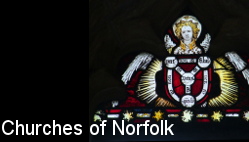
home I index I latest I glossary I introductions I e-mail I about this site
All Saints, Wreningham
Follow these journeys as they happen at Last Of England Twitter.
| All
Saints, Wreningham Wreningham is a large parish and a long village, its houses lining the lanes for more than a mile, with another small settlement on the other side of the old Diss to Norwich road. In fact there were once two Wreninghams, Great and Little, but the distinct settlement and medieval church of the second of these have both disappeared. The church sits on the northern edge of the village. The lower part of the tower is clearly 13th Century, and perhaps the whole church was once, but the nave and chancel were substantially rebuilt in the 15th Century. In 1508, Margaret Newton left 10s to paint the rood, suggesting all was complete by then. However, the long years of post-Reformation neglect took their toll, for in 1853 the upper parts of the tower collapsed into the church and there was a major rebuilding resulting in today's crisp exterior. Unusually, this included the addition of a north transept, hidden from the road. It is, as Pevsner observed, surprisingly large, and can only have been intended to increase the capacity. This is interesting, because at the time of the 19th Century Census of Religious Worship, which took place two years before this major rebuilding, just thirty five of Wreningham's population of more than four hundred and fifty were attending Sunday morning worship here. This was at a time when the church already had a capacity of more than a hundred. The Reverend Thomas Bailey, the no doubt poorly-paid curate employed by the Rector, the Hon Robert Wilson of Ashwellthorpe Hall, had his work cut out because elsewhere in the village a hundred and fifty people were divided between the Protestant Dissenters Chapel and the Independent Chapel, revealing quite a lot about the religious sympathies of this parish. The perky little chimney poking up in the south-east corner of the tower is delightful. Beside it, the clock face is dated for the millennium. You step through the south porch into a church which is pretty much entirely of its 19th Century restoration and adornment. Standing at the west end of the nave it is quite possible to imagine yourself back into the 1880s when the interior was refurnished. Part of this refurnishing was the installation of decorative glass on the south side of the nave commemorating the Golden Jubilee of Queen Victoria which occured that year, and so I wonder if the whole project was for that cause. In a pleasing act of continuity there is a large roundel commemorating the 2012 Diamond Jubilee of Queen Elizabeth II in the west window. The only figurative glass is in the chancel, where the glass by Heaton, Butler and Bayne of about 1900 depicts Christ's entry into Jerusalem, the scene crowded with figures as I'm sure it must have been, but detracting somewhat from a focus here. There are reminders of the earlier life of the parish. Roger Gallard, hujus ecclesiae pastor fidelis, 'faithful shepherd of this church', lies beneath a 17th Century ledger stone bearing a particularly fierce skull, and the reminder that Hodie Mihi Cras Tibi, 'today this is for me, tomorrow it's for you'. Simon Cotton tells me that Gallard was Rector of Wreningham for forty five momentous years, from 1627 in the early years of the reign of Charles I, through the Puritan troubles, the Civil War, the Commonwealth, the Restoration and into the reign of Charles II, dying in 1672. To the west of it is the ghost of a chalice brass, long since removed, a memorial to an earlier priest. These were popular in the period around 1500, and about thirty of them survive in East Anglia. A curiosity that might well be contemporary with it is that the roof wall plate in the chancel has what appear to be the remains of medieval angels on it. A display in the nave depicts an Anglican mission and school in a remote district of the country now known as Zimbabwe, which was founded by the son of a rector of this church in 1900. He called it 'Wreningham All Saints' after his father's church, and so it is still known today. Glass in the east window of the north transept celebrates it, presumably on its centenary in 2000. An even more recent act of remembrance at Wreningham was the planting of a tree at the northern end of the churchyard. A plaque beneath it tells us that this oak tree was planted as a reminder of the world wide effect of covid-19 and was dedicated on 20th March 2022. Simon Knott, May 2023 Follow these journeys as they happen at Last Of England Twitter. |
|
|||||||||||||||||||||||||||||||||||||||||||||||||||||||
home I index I latest I introductions I e-mail I about this site I glossary
links I small
print I www.simonknott.co.uk I www.suffolkchurches.co.uk
ruined churches I desktop backgrounds I round tower churches